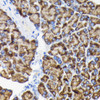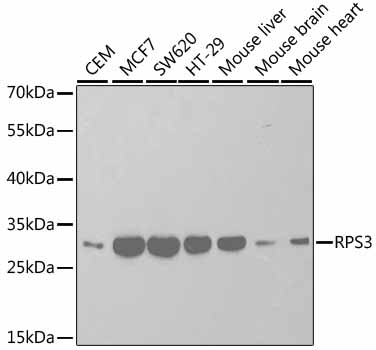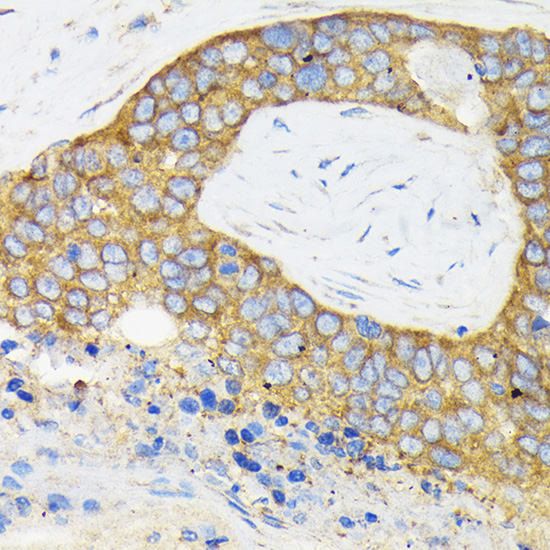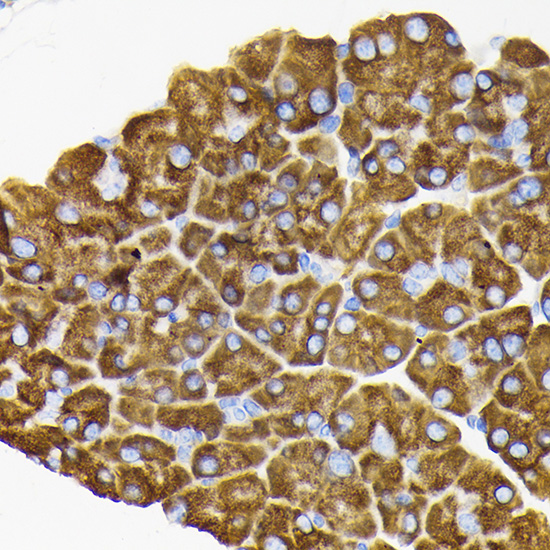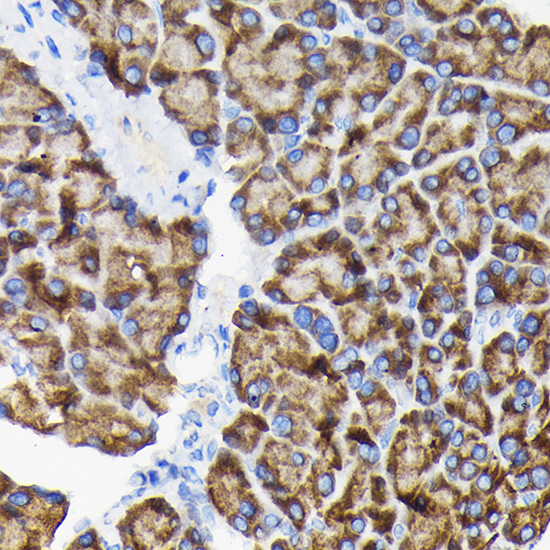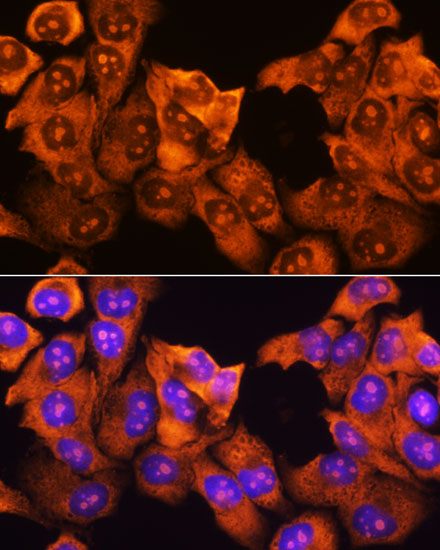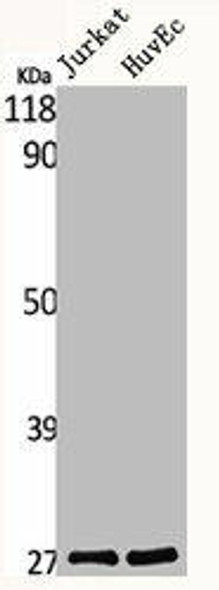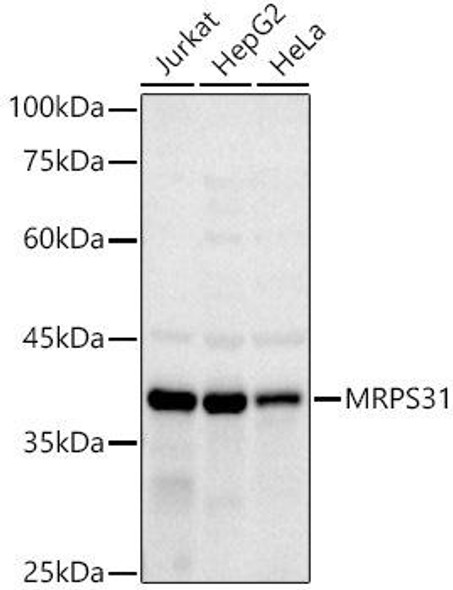Description
Anti-RPS3 Antibody (CAB2533)
The RPS3 Polyclonal Antibody (CAB2533) is a vital tool for researchers studying Ribosomal Protein S3 (RPS3), a key protein involved in protein synthesis and gene regulation. This antibody, produced in rabbits, is highly specific to human RPS3 and has been validated for use in Western blot applications. By binding to the RPS3 protein, this antibody facilitates the detection and analysis of RPS3 expression in various cell types, making it ideal for research in molecular biology and cancer biology.RPS3, a multifunctional protein, is known to play a crucial role in ribosome biogenesis and translation initiation, making it essential for cell growth and proliferation.
Dysregulation of RPS3 has been implicated in various diseases, including cancer, making it a potential target for therapeutic intervention. Studying the function of RPS3 using this antibody can provide valuable insights into its role in disease development and progression, paving the way for the development of novel treatments targeting RPS3 in cancer and other disorders.
| Antibody Name: | Anti-RPS3 Antibody |
| Antibody SKU: | CAB2533 |
| Antibody Size: | 20uL, 50uL, 100uL |
| Application: | WB IHC IF |
| Reactivity: | Human, Mouse, Rat |
| Host Species: | Rabbit |
| Immunogen: | Recombinant fusion protein containing a sequence corresponding to amino acids 1-243 of human RPS3 (NP_000996.2). |
| Application: | WB IHC IF |
| Recommended Dilution: | WB 1:500 - 1:2000 IHC 1:50 - 1:200 IF 1:50 - 1:200 |
| Reactivity: | Human, Mouse, Rat |
| Positive Samples: | CEM, MCF-7, SW620, HT-29, Mouse liver, Mouse brain, Mouse heart |
| Immunogen: | Recombinant fusion protein containing a sequence corresponding to amino acids 1-243 of human RPS3 (NP_000996.2). |
| Purification Method: | Affinity purification |
| Storage Buffer: | Store at -20'C. Avoid freeze / thaw cycles. Buffer: PBS with 0.02% sodium azide, 50% glycerol, pH7.3. |
| Isotype: | IgG |
| Sequence: | MAVQ ISKK RKFV ADGI FKAE LNEF LTRE LAED GYSG VEVR VTPT RTEI IILA TRTQ NVLG EKGR RIRE LTAV VQKR FGFP EGSV ELYA EKVA TRGL CAIA QAES LRYK LLGG LAVR RACY GVLR FIME SGAK GCEV VVSG KLRG QRAK SMKF VDGL MIHS GDPV NYYV DTAV RHVL LRQG VLGI KVKI MLPW DPTG KIGP KKPL PDHV SIVE PKDE ILPT TPIS EQKG GKPE PPAM PQPV PTA |
| Gene ID: | 6188 |
| Uniprot: | P23396 |
| Cellular Location: | Cytoplasm, Mitochondrion inner membrane, Nucleus, Peripheral membrane protein, cytoskeleton, nucleolus, spindle |
| Calculated MW: | 26kDa/28kDa |
| Observed MW: | 27kDa |
| Synonyms: | RPS3, S3 |
| Background: | Ribosomes, the organelles that catalyze protein synthesis, consist of a small 40S subunit and a large 60S subunit. Together these subunits are composed of 4 RNA species and approximately 80 structurally distinct proteins. This gene encodes a ribosomal protein that is a component of the 40S subunit, where it forms part of the domain where translation is initiated. The protein belongs to the S3P family of ribosomal proteins. Studies of the mouse and rat proteins have demonstrated that the protein has an extraribosomal role as an endonuclease involved in the repair of UV-induced DNA damage. The protein appears to be located in both the cytoplasm and nucleus but not in the nucleolus. Higher levels of expression of this gene in colon adenocarcinomas and adenomatous polyps compared to adjacent normal colonic mucosa have been observed. This gene is co-transcribed with the small nucleolar RNA genes U15A and U15B, which are located in its first and fifth introns, respectively. As is typical for genes encoding ribosomal proteins, there are multiple processed pseudogenes of this gene dispersed through the genome. Multiple alternatively spliced transcript variants encoding different isoforms have been found for this gene. |
| UniProt Protein Function: | RPS3: a component of the 40S ribosomal subunit of eukaryotes. Identified in a mRNP granule complex, at least composed of ACTB, ACTN4, DHX9, ERG, HNRNPA1, HNRNPA2B1, HNRNPAB, HNRNPD, HNRNPL, HNRNPR, HNRNPU, HSPA1, HSPA8, IGF2BP1, ILF2, ILF3, NCBP1, NCL, PABPC1, PABPC4, PABPN1, RPLP0, RPS3, RPS3A, RPS4X, RPS8, RPS9, SYNCRIP, TROVE2, YBX1 and untranslated mRNAs. Identified in a HCV IRES-mediated translation complex, at least composed of EIF3C, IGF2BP1, RPS3 and HCV RNA-replicon. Localized in cytoplasmic mRNP granules containing untranslated mRNAs. Overexpressed in colorectal cancer. |
| UniProt Protein Details: | Protein type:EC 4.2.99.18; Ribosomal; Translation; RNA-binding; Apoptosis Chromosomal Location of Human Ortholog: 11q13.3-q13.5 Cellular Component: focal adhesion; membrane; mitochondrial inner membrane; cytoplasm; nucleolus; spindle; ribonucleoprotein complex; nucleus; cytosol Molecular Function:mRNA binding; NF-kappaB binding; protein binding; DNA-(apurinic or apyrimidinic site) lyase activity; enzyme binding; structural constituent of ribosome; protein kinase A binding; oxidized purine base lesion DNA N-glycosylase activity; iron-sulfur cluster binding; damaged DNA binding; protein kinase binding Biological Process: SRP-dependent cotranslational protein targeting to membrane; mitosis; viral reproduction; transcription, DNA-dependent; translation; apoptosis; viral infectious cycle; translational termination; DNA repair; DNA catabolic process, endonucleolytic; activation of NF-kappaB transcription factor; regulation of translation; cellular protein metabolic process; translational elongation; cell division; translational initiation; mRNA catabolic process, nonsense-mediated decay; viral transcription; gene expression; response to DNA damage stimulus; negative regulation of DNA repair |
| NCBI Summary: | Ribosomes, the organelles that catalyze protein synthesis, consist of a small 40S subunit and a large 60S subunit. Together these subunits are composed of 4 RNA species and approximately 80 structurally distinct proteins. This gene encodes a ribosomal protein that is a component of the 40S subunit, where it forms part of the domain where translation is initiated. The protein belongs to the S3P family of ribosomal proteins. Studies of the mouse and rat proteins have demonstrated that the protein has an extraribosomal role as an endonuclease involved in the repair of UV-induced DNA damage. The protein appears to be located in both the cytoplasm and nucleus but not in the nucleolus. Higher levels of expression of this gene in colon adenocarcinomas and adenomatous polyps compared to adjacent normal colonic mucosa have been observed. This gene is co-transcribed with the small nucleolar RNA genes U15A and U15B, which are located in its first and fifth introns, respectively. As is typical for genes encoding ribosomal proteins, there are multiple processed pseudogenes of this gene dispersed through the genome. Multiple alternatively spliced transcript variants encoding different isoforms have been found for this gene. [provided by RefSeq, May 2012] |
| UniProt Code: | P23396 |
| NCBI GenInfo Identifier: | 417719 |
| NCBI Gene ID: | 6188 |
| NCBI Accession: | P23396.2 |
| UniProt Secondary Accession: | P23396,Q498B5, Q8NI95, B2R7N5, J3KN86, |
| UniProt Related Accession: | P23396 |
| Molecular Weight: | 243 |
| NCBI Full Name: | 40S ribosomal protein S3 |
| NCBI Synonym Full Names: | ribosomal protein S3 |
| NCBI Official Symbol: | RPS3 |
| NCBI Official Synonym Symbols: | S3 |
| NCBI Protein Information: | 40S ribosomal protein S3; IMR-90 ribosomal protein S3 |
| UniProt Protein Name: | 40S ribosomal protein S3 |
| Protein Family: | Ribosomal protein |
| UniProt Gene Name: | RPS3 |
| UniProt Entry Name: | RS3_HUMAN |









